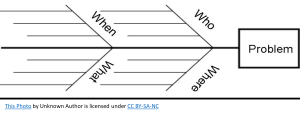3 Identifying and Defining Family Policy Problems
Learning Objectives:
Upon completion of this chapter, you will be able to:
- Differentiate between the terms “problem” and “symptom” in the context of family policy.
- Identify and apply various techniques for effective problem identification.
- Understand and apply strategies for framing problems in the context of family policy, considering factors.
- Analyze a case study of the problem definition in a family policy brief, identifying key components.
- Develop skills in clearly articulating and defining policy problems, taking into account the complex and multifaceted nature of family issues.
- Critically evaluate the effectiveness of problem identification and framing in existing family policy briefs, and provide constructive feedback for improvement.
- Collaborate with peers to identify and frame policy problems related to real-world family issues, demonstrating an ability to apply the techniques and strategies learned in the chapter.

You need to make sure you are identifying the true underlying problem causing the family problem, and this is not always obvious.
3.1 Techniques for Problem Identification
The terms “problem” and “symptom” are often used in various contexts, so understanding the difference between them is crucial for effective problem-solving.
- Problem (The Content Authority, 2023):
- A problem is a primary issue or challenge that needs to be addressed or solved.
- It is the root cause of a situation.
- Addressing a problem often involves understanding its underlying causes and finding a solution that eliminates or reduces these causes.
- For example, affordable housing is a problem.
- Symptom (The Content Authority, 2023):
- A symptom, on the other hand, is a sign or an indication of a problem, but it is not the problem itself.
- Symptoms are the effects or manifestations of a problem.
- They are observable or experienced phenomena that indicate the existence of a deeper issue.
- For example, a symptom of affordable housing is an increased risk of homelessness. As housing becomes increasingly unaffordable, more people are at risk of homelessness, especially during economic downturns or personal financial crises.
What are the best techniques for problem identification? Identifying problems effectively involves several key techniques, each contributing to a comprehensive understanding of the issue at hand. The techniques can be categorized into problem definition, root cause analysis, and creative ideation:
- Define the Problem: This initial step is crucial in problem-solving. It involves distinguishing between facts and opinions, identifying the root causes, consulting all relevant parties, clearly stating the problem, recognizing any violated standards or expectations, pinpointing where the problem occurs in the process, and ensuring enough data is collected before attempting to solve the problem (American Society for Quality, 2023). For example, a family struggles with managing their monthly budget, leading to financial stress. In defining the problem, the family would identify specific issues, such as overspending on non-essential items and underestimating monthly expenses. They would then gather all financial statements and talk to each family member to understand their needs and spending habits, aiming to define the problem without jumping to solutions.
- Root Cause Analysis: This method aims to identify the most critical cause of a problem. A factor is considered a root cause if its removal prevents the problem from recurring. Root cause analysis typically involves a multi-step process, including defining the problem, gathering data on contributing factors, grouping these factors based on shared characteristics, creating a cause-and-effect timeline, and then identifying and evaluating corrective actions to eliminate the root cause (The University of Arizona, 2018). For example, a family notices their child’s declining performance in school. They would start by detailing the problem and gathering information on potential contributing factors like study habits, extracurricular activities, and social environment. By analyzing these factors, they identify that excessive screen time before bed is affecting the child’s sleep and concentration.
- Fishbone Diagram (Ishikawa or Cause-and-Effect Diagram): This visual tool helps identify the causes of a problem. It is designed to generate multiple potential causes and can be effectively used in brainstorming sessions. The diagram’s structure allows for a comprehensive view of the factors contributing to the problem (The University of Arizona, 2018). For example, a family is experiencing tension and arguments during mealtimes. Using a Fishbone diagram, they diagram potential causes into categories:
- People: different meal preferences and lack of participation in meal planning and preparation;
- Processes: inefficient kitchen workflow and no set roles during meal preparation;
- Physical Environment: small kitchen space leading to overcrowding and inadequate cooking tools and equipment;
- Materials: limited availability of ingredients and reliance on processed or fast food due to time constraints;
- Methods: lack of meal planning and no established mealtime routines or schedules; and
- Management: Poor communication about mealtime schedules and expectations and lack of rules or agreements on device use during meals.
By organizing potential causes into these categories, the family can better visualize the complex factors contributing to mealtime tension. This comprehensive view helps in identifying specific areas for improvement, such as improving communication, establishing mealtime routines, and involving all family members in meal planning and preparation. different meal preferences and lack of participation in meal planning and preparation;

- Interrelationship Diagram: This tool shows the relationships among different problems, enabling the identification of common causes and understanding how certain problems impact others. It involves writing down all competing issues and drawing arrows between them to show the direction of influence each has on the others, potentially also depicting the strength of each problem (The University of Arizona, 2018). For example, a family faces challenges with time management, leading to missed appointments and inadequate family time. They create an interrelationship diagram with arrows (similar to mind mapping) to show how time management problems are connected to various issues like missed appointments, work demands, extracurricular activities, and lack of planning. This helps them understand the influence of each problem on others.
- The 5 Whys Technique: This simple process encourages teams to delve deep into the causes of their problems. Starting with the initial problem, the team repeatedly asks “Why?”—usually five times or more—until the true root cause(s) of the situation is uncovered (The University of Arizona, 2018). For example, a family dealing with consistent late morning arrivals at school and work. Starting with the problem, they ask “Why?” multiple times, such as “Why are we consistently arriving late to school and work? Because we wake up late. “Why do we wake up late?” Be we go to bed too late. “Why do we go to bed too late?” Because there’s no set bedtime, and we end up watching TV or using devices until very late. “Why is there no set bedtime or limit on screen time?” Because we haven’t established a strict evening routine or screen time rules. “Why haven’t we established a strict evening routine or screen time rules?” Because we haven’t fully recognized the impact of our evening habits on our mornings and overall daily schedule. The solution is to establish a strict evening routine that includes a set bedtime and limits on screen time to ensure everyone wakes up on time for school and work. This example demonstrates how digging deeper into each answer can reveal the root cause of a problem leading to actionable solutions.
By integrating these techniques, a holistic approach to problem identification can be achieved, facilitating more effective and targeted solutions.
True/False Activity: This activity will test your understanding of various problem identification techniques by applying them to a current family issue. Read each statement carefully and determine whether it is true or false. Each statement applies one of the problem identification techniques to a family issue.
Family Issue: A family is experiencing significant stress due to constant arguments about managing household chores.
3.2 Framing Problems in the Context of Family Policy
Framing problems in the context of family policy involves considering various dimensions and perspectives that impact families. Here’s how you can approach it (Bogenschneider, 2024):
- Identify the Core Issues: Start by identifying the specific issues that families face. This could include economic challenges, access to healthcare, education, childcare, housing, or social support systems. Each issue can have a different impact on families depending on their circumstances.
- Consider the Demographic Diversity: Families come in all shapes and sizes. It’s important to consider the diverse forms of family structures, such as single-parent families, blended families, extended families living together, same-sex parent families, and more. Different policies might be needed for different family types.
- Analyze the Socio-Economic Factors: Socio-economic status plays a crucial role in shaping family experiences. Low-income families may face different challenges compared to middle or high-income families. Policies need to be tailored to address these varied needs.
- Look at Life Stages and Transitions: Families go through various life stages and transitions, such as the birth of a child, children starting school, teenage years, caring for elderly relatives, etc. Policies should be designed to support families through these transitions.
- Assess the Impact of Work and Employment: Employment status, work-life balance, parental leave, and workplace flexibility are significant factors affecting family well-being. Policies that support work and family balance can have a positive impact.
- Evaluate the Cultural and Community Context: Cultural norms and community support systems can greatly influence family dynamics. Policies should respect and reflect cultural diversity and aim to strengthen community support for families.
- Consider Health and Well-Being: The physical and mental health of family members, including access to healthcare and support for those with disabilities or chronic illnesses, is a critical area for policy intervention.
- Address Education and Child Development: Policies should ensure access to quality education and support child development, recognizing the crucial role of early childhood experiences in long-term outcomes.
- Incorporate the Voices of Families: Engaging with families to understand their experiences, needs, and preferences can help in creating more effective and inclusive policies.
- Evaluate Policy Intersections: Understand how different policies (like housing, education, and health) intersect and impact families. This holistic view can lead to more comprehensive and effective family policies.
- Use Data and Research: Employ data and research to understand the issues and to monitor and evaluate the impact of policies.
- Future-Proofing Policies: Consider the long-term implications of family policies, especially in the face of societal changes, technological advancements, and environmental challenges.
By considering these aspects, policymakers can frame family problems more effectively and design policies that are responsive to the real needs and circumstances of families.
3.3 Case Study of Problem Definition in Family Policy
Case Study: “The Challenge of Childcare Accessibility in Urban Areas”

Background
In many urban areas, families are struggling with the challenge of accessing affordable and quality childcare. This issue is especially pressing for low-income families who often face barriers due to high costs, limited availability, and inflexible hours of operation that do not align with non-standard work schedules.
Problem Statement
The core problem is the lack of accessible and affordable childcare options for low-income families in urban settings. This issue leads to several negative outcomes including:
- Parents, especially women, being forced to leave the workforce.
- Children missing out on early educational opportunities.
- Increased financial strain on families.
Root Cause Analysis (Symptoms)
- High Cost of Childcare: In many cities, the cost of childcare is prohibitively high, consuming a significant portion of a low-income family’s budget.
- Limited Availability: There is a shortage of childcare facilities in urban areas, leading to long waiting lists.
- Mismatched Hours: Many childcare centers operate during standard working hours, which does not accommodate parents with non-standard or unpredictable work schedules.
- Quality Concerns: Affordable childcare options often compromise on quality, affecting the developmental benefits for children.
Impact on Families
- Economic: Parents, especially single parents, may be unable to work or forced to take lower-paying jobs with more flexible hours.
- Social: Children may not receive adequate early childhood education, affecting their long-term educational outcomes.
- Health: The stress of managing childcare and work can impact the mental health of parents.
Proposed Policy Solutions
- Subsidized Childcare Programs: Implement income-based subsidies to make childcare more affordable for low-income families.
- Increase Childcare Facilities: Provide incentives for the establishment of more childcare centers in urban areas.
- Flexible Childcare Services: Support childcare providers in offering extended hours and emergency childcare options.
- Quality Assurance Programs: Establish and enforce standards for childcare to ensure a safe and stimulating environment for children.
Implementation Considerations
- Funding: Identify sustainable funding sources for subsidies and incentives.
- Regulation: Develop a regulatory framework to oversee the quality of childcare services.
- Community Engagement: Work with local communities to identify specific needs and preferences.
- Evaluation and Adjustment: Regularly evaluate the effectiveness of the policies and make adjustments as needed.
Conclusion
The lack of accessible and affordable childcare in urban areas is a significant problem for low-income families, affecting their economic stability, social well-being, and the developmental needs of children. Addressing this issue requires a multifaceted approach involving financial support, expansion of services, flexibility in childcare options, and ensuring the quality of childcare.
This case study exemplifies how a specific family policy issue can be framed, analyzed, and addressed through targeted policy solutions, considering the diverse needs and challenges of urban families.
Activity: Identifying and Analyzing Problems in Family Policy
Objective: To help you understand the difference between problems and symptoms and to apply various techniques for effective problem identification and analysis within the context of family policy.
Group Activity – Problem Definition:
- You will be divided into small groups.
- Each group will be assigned a specific issue related to family policy (e.g., affordable housing, education inequalities, healthcare).
- Each group will define the problem using the techniques outlined in this chapter (problem definition, root cause analysis, etc.).
- Your are encouraged to use data and research where possible.
- Each group will create their own Fishbone Diagram for their assigned issue.
- You will facilitate a 5 Whys exercise to delve deeper into the root causes.
Framing Problems in Family Policy Context
- Case Studies:
-
- The instructor will provide short case studies that illustrate different family policy issues.
- You will identify the core issue, demographic diversity considerations, socio-economic factors, etc., based on the framework provided (Bogenschneider, 2014).
- Role-Playing:
-
- Each student will be assigned different roles (policymakers, family members, social workers) to discuss how he/she would address the issues from his/her perspectives.
- Your are encouraged to consider cultural, community, and employment impacts on the family policy issue.
Presentation and Discussion
- Group Presentations:
-
- Each group will present their findings and proposed solutions.
- You are encouraged to ask questions and offer feedback.
- Wrap-Up Discussion:
-
- The instructor will facilitate a discussion on the importance of understanding and addressing both the symptoms and the root causes of family policy issues.
- the instructor will highlight the role of data, research, and diverse perspectives in developing effective family policies.
Assessment:
Evaluate students based on their participation in discussions, the effectiveness of their problem identification in group activities, and the quality of their group presentations.
References:
American Society for Quality. (2023). What is problem-solving? https://asq.org/quality-resources/problem-solving
Bogenschneider, K. (2024). Family policy matters: How policymaking affects families and what professionals can do (4th Ed.). Routledge Publications.
The Content Authority. (2023). Problem vs symptom: Deciding between similar terms. https://thecontentauthority.com/blog/problem-vs-symptom
The University of Arizona. (2018). Strategies for problem cause identification. Eller Executive Education. https://executive.eller.arizona.edu/news/2018/11/strategies-problem-cause-identification

